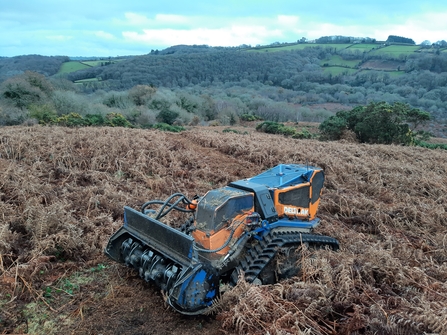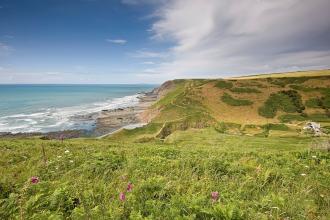4 fritillaries, 12 nature reserves, more than 100 hectares
Across England, many fritillary butterfly species have declined dramatically over the last 40 years.
The story is different in Devon. Targeted conservation work has seen astonishing success stories on DWT's nature reserves for some of our rarest species. For example, at a time of continuing national declines, the small pearl-bordered fritillaries saw an increase of 1,636% between 1988 and 2010 at Marsland nature reserve.
For the first time, DWT has the chance to expand 30 years worth of experience across 12 of its nature reserves to help four fritillary butterflies - high brown, pearl-bordered, small pearl-bordered and marsh fritillary.

Machines and muscle
Until recently, much of the habitat management on DWT's nature reserves has been carried out manually by hard working trainees and volunteers. With limited capacity and short time windows to carry out this work, we can't create perfect conditions on every nature reserve for fritillary populations to thrive and spill over into neighbouring areas.
This is where machinery can lend a helping hand - creating new opportunities to manage bracken, rush and scrub on steep slopes, wet mires and other terrain that is difficult to access on foot with hand-held tools. This new project is the first time we will have the right machinery and additional staff time to improve habitats for these butterflies in more areas, more efficiently.

Tree pipit © Derek Moore
The birds and the beetles
Restoring and re-creating habitats for these four fritillary species will create knock on benefits for other wildlife. We should see increases of other wildlife including tree pipits, nightjars and Kugelann’s green clock beetles on Dartmoor, and grasshopper warblers, lesser butterfly orchids and keeled skimmer dragonflies on wet grassland sites.
Marsland
Why Devon?
Despite national declines, Devon remains a vital stronghold for these four fritillaries, so it is critical to secure their long-term futures here. DWT can play a pivotal role by helping populations recover on our own nature reserves, many of which lie at the heart of important fritillary habitats.
DWT has 30 years of experience restoring habitat for all four species. We pioneered successful bracken management techniques that have since been widely adopted nationally. By understanding the life cycle of the butterflies, we can create just the right mix of light and shade at different times of year for egg-laying and for their caterpillars to feed on violets.
Explore DWT's nature reserves - home to these rare butterflies
Get in touch
Jenny Cawson
Species Recovery Officer (Devon Fritillary Recovery Project)
Generously funded by

This project is made possible thanks to the support of Natural England’s Species Recovery Programme Capital Grant Scheme.




